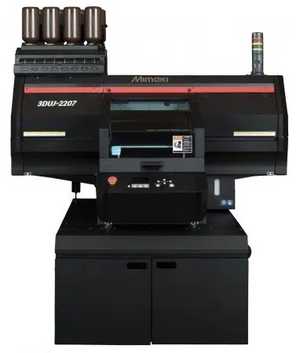Material Jetting: Difference between revisions
No edit summary |
|||
| (15 intermediate revisions by the same user not shown) | |||
| Line 1: | Line 1: | ||
==Process description== | ==Process description== | ||
Material Jetting is an advanced extension of ink jet tech used by conventional 2D printers. A print head deposits a small amount of either liquid or particles which is fused to the rest of the print using different methods depending on the material type. This process is most often used with a UV curable resin, but processes also exist for metals and ceramics. | |||
== Strengths & Weaknesses == | == Strengths & Weaknesses == | ||
* | === Strengths === | ||
* | * '''Resolution:''' High precision print heads allow for very fine detail. | ||
* '''Multi-material printing:''' Multiple jets in the print head make it possible to print multiple materials together. | |||
* | |||
* | === Weaknesses === | ||
* | * '''Supports required:''' Supports are required for overhangs. | ||
* | * '''Post processing:''' Parts often require a second cure to fully harden. | ||
* '''Limited materials:''' Material Jetting printing is limited to waxes and photopolymers. | |||
* '''Slow print times:''' Since very little material is placed down at a time, production times can be very slow. | |||
== Machine Ranges == | |||
Material Jetting is capable of producing high resolution parts at large sizes. | |||
{| class="wikitable" | {| class="wikitable" | ||
! | ! | ||
! | !Worst | ||
! | !Best | ||
|- | |- | ||
| | |Volume X/Y/Z (mm) | ||
|200/100/40 | |200/100/40 | ||
|1450/1110/1800 | |1450/1110/1800 | ||
|- | |- | ||
| | |Resolution (mm) | ||
| | |.03 | ||
|. | |.02 | ||
|- | |- | ||
| | |Layer Height (um) | ||
|50 | |||
|10 | |10 | ||
| | |- | ||
|Price ($) | |||
|Requires | |||
|Quotes | |||
|- | |||
|Weight (kg) | |||
|211 | |||
|4751 | |||
|} | |||
[[File:3duj-2207.webp|none|thumb|[https://www.mimakiusa.com/products/3duj-2207/ 3duj-2207]]] | |||
{| class="wikitable" | |||
!Build Volume | |||
!Layer Height | |||
!Resolution | |||
!Size xyz | |||
! Power | |||
!Price | |||
!Weight | |||
|- | |||
|203/203/76mm | |||
|28um | |||
|.03mm | |||
| 1355/1290/856mm | |||
|350w | |||
|$42,000 | |||
|140 | |||
|} | |} | ||
==Technologies== | ==Technologies== | ||
NPJ: created by XJet | '''Nano Particle Jetting (NPJ):''' A proprietary process created by XJet that involves suspending metal or ceramic particles into a suspension material. After printing, the part is put through a sintering step leaving a metal or ceramic part. | ||
'''Supersonic Paricle Deposition (SPD):''' Also known as cold spraying, this process accelerates metal particles to high speeds such that they bind to each other. | |||
'''Gel Dispensing Printing (GDP):''' A proprietary process created by Massivit that uses a UV resin gel. | |||
==Navigation== | |||
*[https://omic-am.mme.pdx.edu/index.php/Main_Page?veaction=edit Home page] | |||
*[[Material extrusion|Material Extrusion]] | |||
*[[Powder Bed Fusion]] | |||
*[[Vat Polymerization]] | |||
*[[Direct Energy Deposition]] | |||
*[[Binder Jetting]] | |||
*[[Material Jetting]] | |||
*[[Sheet Lamination]] | |||
==References== | |||
Rosen, Stucker, and Khorasani, Additive Manufacturing Technologies, chap. 7. | |||
“Material Jetting - MJ, NPJ, DOD | Make.” Accessed October 6, 2023. <nowiki>https://make.3dexperience.3ds.com/processes/material-jetting</nowiki>. | |||
Latest revision as of 12:46, 24 October 2023
Process description
Material Jetting is an advanced extension of ink jet tech used by conventional 2D printers. A print head deposits a small amount of either liquid or particles which is fused to the rest of the print using different methods depending on the material type. This process is most often used with a UV curable resin, but processes also exist for metals and ceramics.
Strengths & Weaknesses
Strengths
- Resolution: High precision print heads allow for very fine detail.
- Multi-material printing: Multiple jets in the print head make it possible to print multiple materials together.
Weaknesses
- Supports required: Supports are required for overhangs.
- Post processing: Parts often require a second cure to fully harden.
- Limited materials: Material Jetting printing is limited to waxes and photopolymers.
- Slow print times: Since very little material is placed down at a time, production times can be very slow.
Machine Ranges
Material Jetting is capable of producing high resolution parts at large sizes.
| Worst | Best | |
|---|---|---|
| Volume X/Y/Z (mm) | 200/100/40 | 1450/1110/1800 |
| Resolution (mm) | .03 | .02 |
| Layer Height (um) | 50 | 10 |
| Price ($) | Requires | Quotes |
| Weight (kg) | 211 | 4751 |
| Build Volume | Layer Height | Resolution | Size xyz | Power | Price | Weight |
|---|---|---|---|---|---|---|
| 203/203/76mm | 28um | .03mm | 1355/1290/856mm | 350w | $42,000 | 140 |
Technologies
Nano Particle Jetting (NPJ): A proprietary process created by XJet that involves suspending metal or ceramic particles into a suspension material. After printing, the part is put through a sintering step leaving a metal or ceramic part.
Supersonic Paricle Deposition (SPD): Also known as cold spraying, this process accelerates metal particles to high speeds such that they bind to each other.
Gel Dispensing Printing (GDP): A proprietary process created by Massivit that uses a UV resin gel.
- Home page
- Material Extrusion
- Powder Bed Fusion
- Vat Polymerization
- Direct Energy Deposition
- Binder Jetting
- Material Jetting
- Sheet Lamination
References
Rosen, Stucker, and Khorasani, Additive Manufacturing Technologies, chap. 7.
“Material Jetting - MJ, NPJ, DOD | Make.” Accessed October 6, 2023. https://make.3dexperience.3ds.com/processes/material-jetting.
